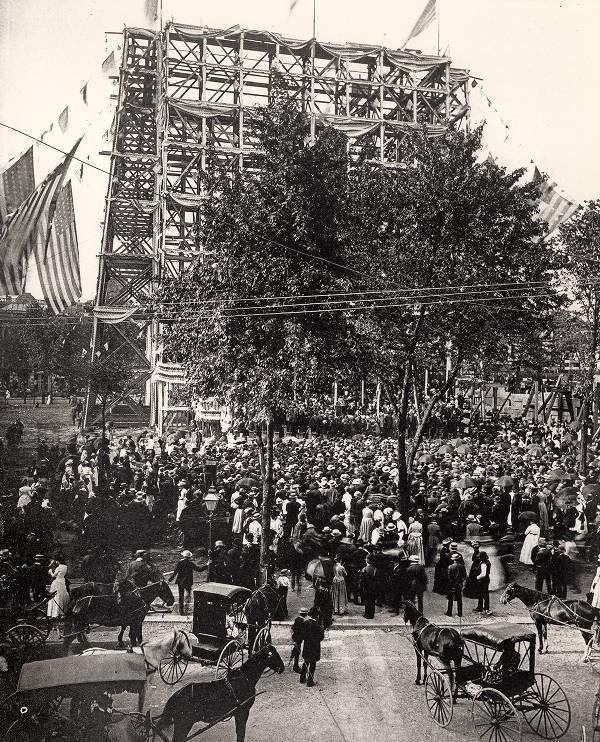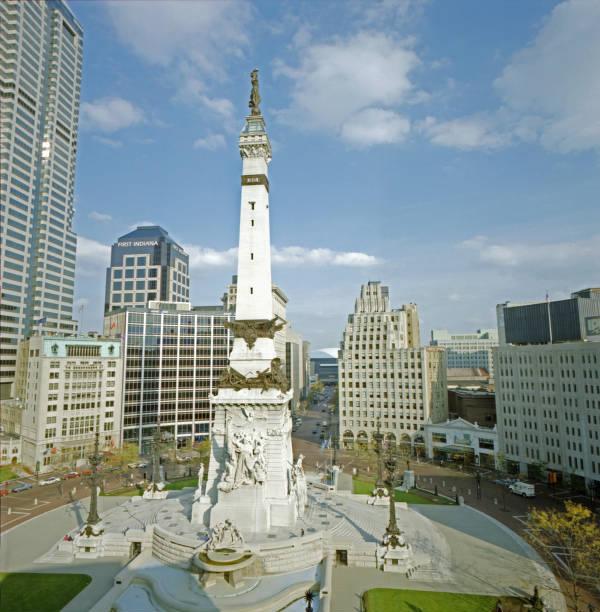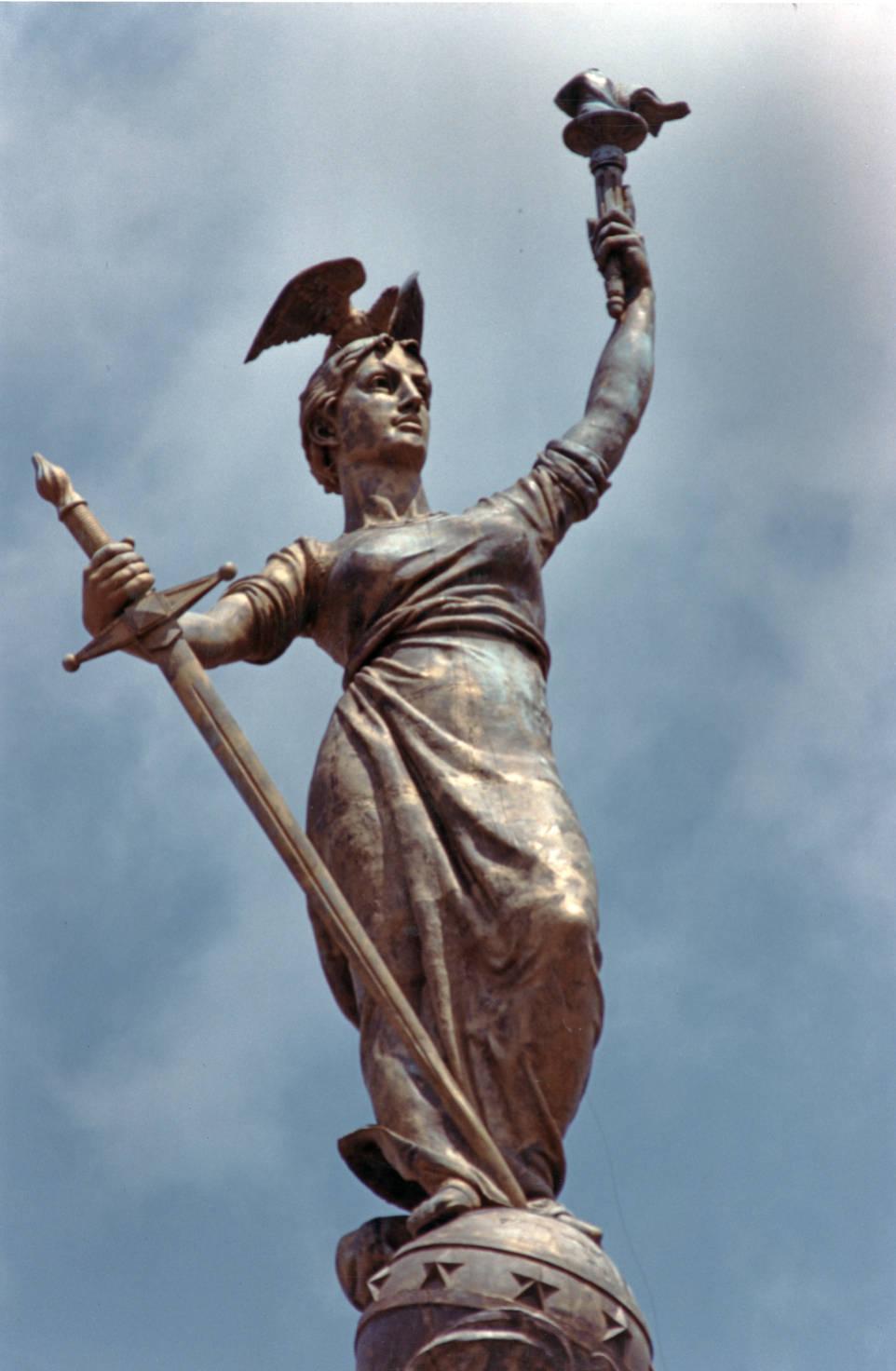The Soldiers and Sailors Monument is Indianapolis’ “signature” structure, located in the center of the city’s original plat. Conceived, designed, and built as the state’s memorial to Indiana’s Civil War dead and its veterans, the Indiana State Soldiers and Sailors Monument was built from 1888 to 1901.

Governor initiated the first public discussion of a Civil War monument soon after the war ended. Following two decades of lobbying led by George J. Langsdale, Civil War veteran and editor of the Greencastle Banner, the General Assembly in 1887 appropriated funds and designated a commission to plan and oversee construction of a suitable memorial.
An international design competition was held in 1887 with the winning entry selected the following year. The commission was looking for a design for an original “American Monument” free of the iconography of antiquity. German architect Bruno Schmitz, who became Wilhelmine Germany’s greatest monument designer, submitted the winning proposal from among 70 designs.
The monument, Schmitz’s only surviving work outside Germany and Switzerland, was integrated into the Circle location with terraced steps, fountains, pools, gardens, an obelisk shaft, and an abundance of statuary. A comparison of the built monument and to the original design reveals variations in some of the statuary, such as Victory’s loss of wings.
Construction began with the laying of the foundation in 1888, and the cornerstone was set on August 22, 1889. The shaft was constructed between 1889 and 1892. The first pieces of sculpture added were the Date Astragal, a sculptured band, in 1892, and the crowning figure of Victory in 1893.

The two bronze pieces are the work of sculptor George T. Brewster, who won the two design competitions. Brewster also sculpted the bronze naval astragal following another design competition. Installed in 1892, it depicts the prow of the USS Hartford. The fourth sculptural competition for the monument was won by German sculptor Nicolaus Geiger. His bronze army astragal was cast in Berlin and installed in 1895.
By 1893, the World’s Columbian Exhibition in Chicago was attracting design competitors away from the Indianapolis monument, forcing the commissioners to suspend further competitions. Frustration over the delay in the monument’s completion led the General Assembly to dissolve the Board of Monument Commissioners in 1895 and replace it with the Board of Monument Regents. The regents turned to Schmitz to expedite the completion of the monument. He supplied designs for the remaining sculptures, lamp standards, and cascade fountains.
The Regents commissioned Austrian sculptor, , in 1899 to execute the massive War and Peace sculptural groups, designed by Herman P. Matzen, as well as to design and execute the four sentry figures and the fountain cascade sculptures. Schwarz, a native of Vienna, had worked with Schmitz on his many projects in Germany. Concerned about realism and accuracy, Schwarz originally sculpted the limestone soldiers with beards but shaved them when told by regent president, Gen. of the youthfulness of the Indiana troops he commanded.
After 14 years of construction, the monument was completed in 1901 and formally dedicated on May 15, 1902. The gala event, for which Indianapolis attorney, military officer, and author of was master of ceremonies. Hoosier poet recited “Messiah of the Nations,” which John Philip Sousa transformed into a march. Sousa also attended the ceremony and performed. They both wrote their compositions for the occasion. John W. Foster, an Indiana native and secretary of state under , delivered the principal address.

The monument has had a lasting impact on Indianapolis and Indiana. It has been the focus and symbol of the city, dominating the downtown skyline until the arrival of the high-rise office buildings. It redefined the Circle and the local perception of civic and monumental architecture and open spaces, a definition reinforced by the massive of the following generation.
The monument also launched the career of Rudolf Schwarz as Indiana’s monument sculptor and designer. He later executed several county memorial monuments and taught sculpture at the John Herron Art Institute.
The monument also continued its role as a civic focal point for celebrations, festivals, and memorial services staged on its terraces. Following World War II, the city began to add decorations to Monument Circle to mark the holiday season. Each year the decorations became more elaborate, until, in 1962, a holiday committee strung lights on the Soldiers and Sailors Monument to transform it into an artificial Christmas tree. This practice has continued as “The Celebration of Lights.” Although often described as the “World’s Largest Christmas Tree,” Guinness World Records recognized a 236-foot-tall Christmas tree in Colombo, Sri Lanka, for that honor in 2016.
The structure has changed little since its completion but was the object of much-needed major restorations from 1986 to 1990, and 2011 to 2015. The monument is listed in the National Register of Historic Places and is a National Historic Landmark (NHL) as part of the amended (2016) NHL Indiana War Memorials Historic District.

Help improve this entry
Contribute information, offer corrections, suggest images.
You can also recommend new entries related to this topic.